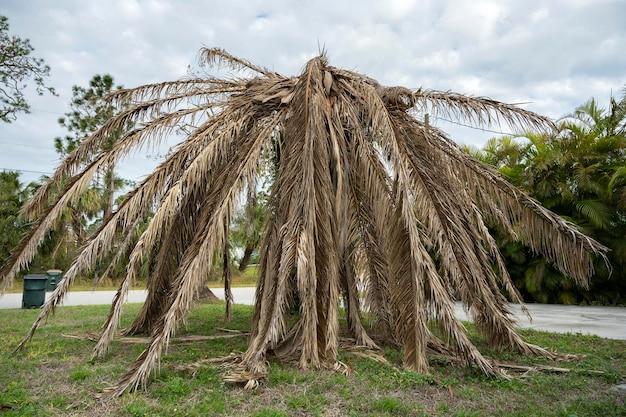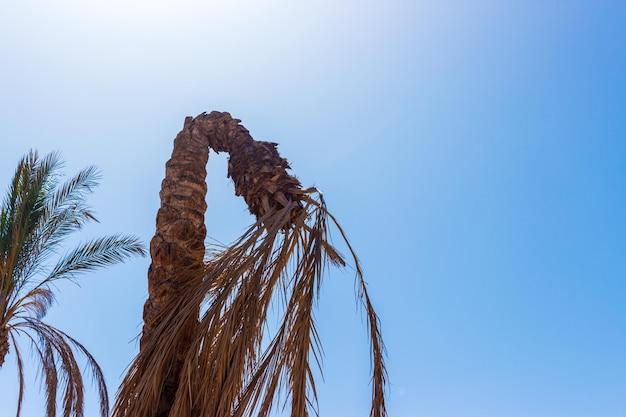Have you noticed that your once vibrant palm tree is looking a bit under the weather? Are its leaves turning brown or yellow, leaving you wondering if it’s dead or just in need of some TLC? If so, you’ve come to the right place. In this blog post, we will discuss the signs that indicate a palm tree may be on its last legs, as well as provide tips on how to revive a dying palm tree.
Palm trees are known for their resilience and ability to withstand challenging conditions, but they are not invincible. Various factors can contribute to the decline of a palm tree, such as disease, pests, lack of proper care, extreme weather, or simply old age. Identifying the early warning signs of a dying palm tree is crucial in order to take appropriate action before it’s too late.
Throughout this article, we will answer common questions like “Can a palm tree heal itself?” and “Should I cut off brown palm leaves?” We will also explore the steps you can take to bring a dead palm tree back to life, including watering, fertilizing, pruning, and providing the necessary sunlight. So, let’s dive in and learn how to assess the health of your palm tree and work towards reviving it in the process.
How to Determine if Your Palm Tree Has Kicked the Bucket
Checking for Signs
When it comes to our beloved palm trees, it can be quite a heartbreaking experience to see them withering away. But fear not! There are ways to tell if your palm tree has truly met its unfortunate demise. Just follow these simple steps to become the ultimate palm tree detective.
The Shrivel Test
The first thing you’ll want to do is get up close and personal with your palm tree. Examine the fronds, those majestic leaves that sway in the breeze. If they appear yellow, brittle, and downright lifeless, it’s a clear indicator that your tree is a goner. And if they fall off with the gentlest of touches, well, let’s just say it’s time to start planning the funeral.
A Tug and a Twist
Next up, it’s time to give that palm trunk a gentle tug and a twist. Don’t worry, we’re not asking you to perform a horticultural wrestling match here. Just a little test to see if it puts up any resistance. A healthy palm tree will put up a fight, with a sturdy trunk that refuses to budge. But if your tree wobbles like a drunken sailor, it’s safe to say it has joined palm tree heaven.
Signs of Decay
Before you go calling the palm tree undertaker, there are a few more telltale signs of decomposition to look out for.
The Smell Test
Take a deep breath. Can you smell that? If your nostrils are greeted with an unpleasant odor reminiscent of a rotting compost pile, consider it a warning sign. A foul stench emanating from the base of the tree could mean that decay has set in, and your palm tree is beyond resuscitation.
Hollow at the Core
Grab a trusty tool (make sure it’s sanitized, we don’t want any cross-pollination of tree diseases), and give the trunk a gentle poke. If it feels hollow or starts to crumble under your probing, Houston, we have a problem. A healthy tree should be as firm as a well-toned bicep, but a decaying palm tree will give way like a soggy melon.
The Dryness Test
Now, it’s time to get down and dirty with a little soil investigation. Take a good, hard look at the ground surrounding your palm tree. Is it as dry as your aunt’s turkey on Thanksgiving? A thirsty palm tree will suck up water like a parched desert wanderer, leaving those surrounding soils bone dry. If the soil feels like sandpaper and refuses to hold moisture, it’s another grim sign that your tree has given up the ghost.
Farewell, Old Friend
If your palm tree fails all the tests above, it’s time to face the somber reality: it has taken its final bow. But fear not, for nature is a cycle of life and rebirth. Plant a new palm and watch as it grows, thriving in the memory of its fallen predecessor. And who knows, maybe this time you can even manage to keep it alive longer than that goldfish you had in college.
FAQ: How to Tell If a Palm Tree Is Dead
Can a Palm Tree Heal Itself
Palm trees are impressive creatures, but unfortunately, they can’t perform miracles. Once a palm tree is dead, it cannot revive itself. However, under certain conditions, certain species of palm trees can recover from partial damage. It’s essential to act quickly and provide proper care to give your palm tree the best chance of recovery.
Why Are My Outdoor Palm Tree Leaves Turning Brown
Ah, the age-old question of brown palm leaves. It’s like a rite of passage for palm tree owners. Brown leaves are often a sign of trouble, indicating either a lack of water or nutrient deficiency. It could also be a result of cold weather, pests, diseases, or simply old age. So, treat your palm tree with some tender loving care, make sure it’s getting enough water and nutrients, and keep an eye out for any unwanted visitors!
How Do You Know If Palms Are Dead
The palm tree mortality dilemma! To determine if your palm tree has sadly reached the end of its life, there are a few signs to watch out for. Dead palm trees usually have completely brown, brittle, or drooping leaves. You may also notice the absence of new growth, a trunk that wiggles easily, or a lack of regrowth after a severe pruning. Don’t lose hope, though! Sometimes, a palm tree might surprise you with a miraculous recovery.
What Is Wrong with My Palm Tree
Oh dear, your palm tree is feeling under the weather? Several issues could be afflicting your green friend. It could be facing nutrient deficiencies, mineral imbalances, root rot, fungal infections, or even insect infestations. Identifying the exact cause of the problem might require the skills of a certified arborist. So, call in the pros to work their magic and nurse your palm tree back to health!
Should I Cut off Brown Palm Leaves
Trimming brown palm leaves goes hand-in-hand with being a responsible palm tree parent. Not only does it make your tree look tidier, but it also helps prevent diseases and pests from finding a cozy home amidst the dead foliage. But don’t go too scissor-happy! Avoid removing green leaves unnecessarily, as they contribute to the tree’s overall health.
Do Palm Trees Go Dormant
Yes, they do! Palm trees enter a period of dormancy during colder months or when subjected to adverse conditions. Their growth slows down, leaves may turn yellow or brown, and they may appear less vibrant. However, it’s crucial to differentiate between dormancy and actual damage or disease. Keep a watchful eye on your palm tree, and if you suspect something more sinister, seek professional advice.
Should I Cut Down My Palm Trees
Deciding to chop down your palm tree is never an easy choice. It’s like saying goodbye to an old friend. However, there are instances where removal is necessary – if your palm tree has died, become a safety hazard, or is causing significant structural damage. Consider consulting an arborist to assess the situation and help you bid a fond farewell if needed.
How Do I Make My Palm Tree Greener
Ah, the quest for vibrant greenery! To make your palm tree happy and green, start with proper care. Ensure it gets enough sunlight, water it regularly (but don’t drown it), and feed it a balanced fertilizer. Avoid those quick-fix promises of miracle products; palm trees appreciate a consistent and caring touch. With patience and the right care, your palm tree will dazzle you with its lush, green beauty.
Will a Palm Tree Grow Back
Wishing for a phoenix-like resurrection of your palm tree? Well, it largely depends on the extent of the damage and the specific species. While some palm trees can recover from a partial trimming or damage, others may struggle to grow back once they have been severely impacted. As a palm tree parent, make sure to provide the necessary conditions and care to support your tree’s regrowth.
How Often Should Palm Trees Be Watered
Ah, the watering question – the eternal struggle for any plant owner. When it comes to palm trees, watering requirements vary depending on several factors, including the species, climate, and soil conditions. As a general rule, palm trees appreciate a thorough watering once or twice a week, allowing the soil to dry out slightly between waterings. However, it’s always wise to research the specific needs of your palm tree species to ensure it receives the hydration it craves.
What Is the Lifespan of a Palm Tree
A palm tree’s lifespan is a matter of perspective. Some palm tree species can live for hundreds of years, standing tall and proud like ancient sentinels. Yet, others have a less impressive lifespan, typically ranging from 30 to 100 years. So, cherish your palm tree, as it may very well be a magnificent, long-lasting companion!
What Does a Dying Palm Tree Look Like
Spotting a dying palm tree can be a heart-wrenching experience. Signs of impending doom include yellowing or browning leaves that progressively wither and die, a trunk that appears hollow or decaying, and a lack of new growth. Remember, though, that not all symptoms are irrevocable. Don’t hesitate to seek professional assistance to determine if there’s still hope for your beloved palm tree.
Do Dead Palm Trees Fall Down
Well, just like us, palm trees can eventually lose their footing and topple over. If not removed timely, dead palm trees can become a potential hazard. They may succumb to strong winds, heavy storms, or even their own weight. So, to avoid any unwanted mishaps, it’s best to say goodbye to your fallen friend and remove it from your property.
How Do You Bring a Dead Palm Tree Back to Life
The ultimate question: how to revive a dead palm tree? Unfortunately, once a palm tree is completely dead, it’s beyond revival. The focus must shift to prevention and early intervention. By providing proper care, including watering, fertilizing, pruning, and protecting your palm tree from pests and diseases, you’re setting the stage for a happy and healthy tree that will hopefully live a long, fulfilling life.
Why Is My Palm Tree Turning Yellow and Brown
Yellow and brown palm leaves are a cry for help! This could indicate an array of concerns such as overwatering, underwatering, nutrient deficiencies, or even a compacted root system. Don’t let your palm tree suffer in silence! Investigate the potential causes, make the necessary adjustments to its care routine, and give it the TLC it deserves.
Can Brown Palm Leaves Turn Green Again
In most cases, brown palm leaves cannot magically transform back to green. However, if the cause of the browning is addressed promptly and the palm tree receives proper care, it might produce new healthy green leaves over time. Remember, patience is key, and your palm tree may surprise you with its resilience and determination to bounce back.
Now you’re armed with knowledge to read the palm tree’s signs and provide the necessary care for your verdant friend. Remember, a little love, attention, and maybe a sweet serenade now and then can work wonders for your palm tree’s health and happiness. Happy palm tree parenting!
Note: This blog post is for informational purposes only and does not substitute professional advice. If you’re unsure about your palm tree’s condition, consult a certified arborist.

